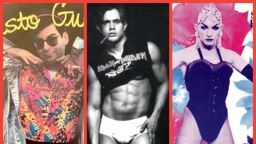
LGBTQ+ bars have undergone a startling decline globally over the past 20 years. More than half of London’s LGBTQ+ venues closed between 2006 and 2016, and the U.S. has seen a similar trend, where an average of 15 gay bars have closed every year from 2008 to 2021.
“Save your tears, because queer nightlife is alive and well,” writes the New York Times in its review of Amin Ghaziani‘s buzzy new book, Long Live Queer Nightlife: How the Closing of Gay Bars Sparked a Revolution. “In fact, it’s even better than ever, having evolved into a more progressive, sophisticated form.”
The following is an excerpt from Long Live Queer Nightlife, available now from Princeton University Press.
How about we take this to the next level?
Subscribe to our newsletter for a refreshing cocktail (or mocktail) of LGBTQ+ entertainment and pop culture, served up with a side of eye-candy.
When we go out, whether to a gay bar that has survived or a club night, we connect with our history, who we are, where we were, where we want to be. “It’s nice to think of a party or a space as a way of organizing people’s engagement with the past,” Brooke shares with me. We like this feeling, Simon, the producer of Duckie, says: “People like history. They like heritage. They like having a past, and hopefully a future.”
Nightlife is important because it proves we exist. “We’re all walking vessels of history,” Damien, an education officer at Parliament, adds, “but sometimes we don’t realize it unless we meet others, and we talk about it.” We need to see ourselves through the lens of people and places. “And then you get ripples,” Damien continues. “It’s like a pond. Someone chucks in a stone, and you get all these ripples of memory and history, and you’re swimming in that pool together.”
London’s institutional offerings, what it does and especially does not have, make nightlife feel extra special. “London’s really shoddy for queer institutions,” Ben Walters quips. How do you mean? I ask. “We don’t have a museum at the moment,” he replies, and then uses repetitions to express a larger point. “We don’t have a community center at the moment. We don’t have an AIDS memorial at the moment. We don’t have any of these sites that affirm to queer people that we have been here in this city for a long time, forever, and that we matter, and that we have a stake in not just our own lives and the lives of the people that we love, and respect, and cherish—but in the city. The closest thing to that is nightlife venues.”
Ben and I have spent a lot of time together during my visits to London, both one-on-one and on dance floors with friends. “Historically, the only spaces that are like institutional places with an institutional lineage of queer use are nightlife venues,” he says. To feel a sense of continuity is powerful, and nightlife provides that. As I listened, I heard distant echoes of Descartes: we come together at night, therefore we are. Or more simply: nightlife, therefore we are.
The pain we feel when a place closes is further proof, visceral proof, of how important it was, how much we value and need places in general, and the link they provide between us, each other, and our histories. Zax, a museum assistant, told me about a project called “This Dancefloor Isn’t Here Anymore.” The performance art piece, held on Valentine’s Day in 2018, portrays “acts of remembrance” which “summon up that history, the disappearance of spaces.” On their social media page, Zax wrote: “Queers! Is this the end of London? Or is it the beginning? This is a one-night living archive of transient queer spaces and moments, through performance, through intimacy.”
Zax invites us to reflect on why nightlife matters. “Have you ever fallen in love on the dance floor? Can you still taste the freedom and fear the first time you kissed another queer person? Do you remember taking your first pill? Have you ever fallen in love with a room full of strangers all at once? Can you imagine, beyond surviving in London, what would it look like for us to thrive, to flourish?” The performance was about the “mourning of queer spaces that we have loved and lost,” Zax tells me. They expressed grief as “a queer remix of the Kaddish,” which is “the Jewish prayer that you would say over someone’s dead body.” By importing it into nightlife, “we say goodbye to spaces that we’ve lost.” Even so, Zax can still imagine a more hopeful future. “We invoke or summon a new queer city” where queer nightlife can insist and persist.
Prem uses art to mirror life above ground, like Zax, but also to inspire gatherings below it. They are part of a collective of “London’s finest young artists” who are “doubling up as party planners” to produce a club night called Anal House Meltdown, the “artiest-not-fartiest” underground party, “cult night,” and “queer party with the best name,” as i-D describes in multiple feature stories.
Prem once did an exhibition at an art gallery “when Soho began to be very boarded up.” The closure of bars, their meltdown, informed Prem’s art practices. “Because I noticed that there was lots of shutter boarding on windows, and signs taken down, and empty venues, I tried to mirror that with the gallery space.” The inside reflected the world outside. “I boarded the whole gallery up. I invited people to use the gallery as a meeting space. I just put benches in there, and it became a quite bleak view about the closure of spaces during that time because as you stood inside the gallery, you could only see the wood through the windows. There wasn’t a view outside of it.” Prem’s gallery might sound grim, but it inspired them to create Anal House Meltdown. They express this motivation concisely: “Nightlife is part of our artmaking.”
So powerful are the feelings we have for nightlife that the closure of a beloved venue can feel like the loss of a limb, as it did for Jon. “When a place closes down, that’s a loss. You lose a finger. You lose an arm. It’s not very nice.” The image is intense, and I can feel it in my body as he describes it. “When a place closes down, it’s just part of you—I’m going to be dramatic now—part of you dies with that place.”
Mourning, prayers over dead bodies, the loss of limbs, dying with a place: these are unforgettable metaphors for why nightlife matters— and the message is mighty. We feel a strong connection with the places where we gather, our cultural homes, and we grieve when they close. That sense of agony and anguish was felt even by those people who did not particularly like gay bars, or did not always feel welcome in them, attesting to the considerable power of nightlife more broadly. What I heard over and over again, implicitly and explicitly, is that nightlife provides proof of existence, evidence that we were here, evidence that we are still here.
Reprinted with permission. Long Live Queer Nightlife: How the Closing of Gay Bars Sparked a Revolution by Amin Ghaziani is available now from Princeton University Press.
Related*


PHOTOS: Step back in time to New York’s queer club scene of the 1990s
The following is an excerpt from “GETTING IN: NYC Club Flyers from the Gay 1990s” by David Kennerley with a foreword by Michael Musto














































